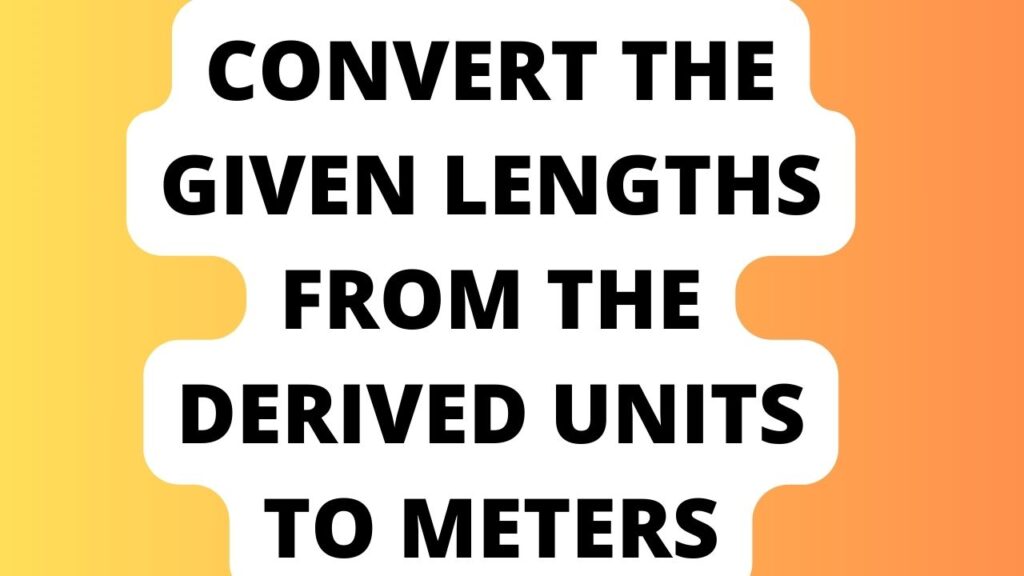Introduction
Convert the Given Lengths From the Derived units to Meters Navigating through the world of measurements often involves converting lengths from various derived units to meters. This fundamental aspect of metrology lies at the heart of precision and accuracy in scientific calculations, industrial applications, and everyday tasks.
What Are Derived Units?
Derived units stem from fundamental units and provide measurements for various physical quantities. These units, composed of base units through mathematical operations, offer diverse measurements, enhancing precision in specific contexts.
Importance of Unit Conversion
Unit conversion ensures seamless communication and consistency across diverse fields. It facilitates global standardization, enabling efficient data exchange and comprehension among professionals in science, engineering, and everyday life.
Defining Derived Length Units
Derived length units, integral in scientific and engineering disciplines, encompass measurements such as velocity, acceleration, and force. Examples include meters per second (m/s), meters per second squared (m/s²), and newtons (N).
What are Derived Units?
Derived units stem from combinations of base units in the International System of Units (SI) and play a crucial role in expressing complex measurements.
Importance of Unit Conversion
Understanding and executing accurate unit conversions are pivotal for ensuring consistency and coherence across diverse fields, from physics and engineering to everyday measurements.
Understanding Conversion
Basic Unit Conversion
The process of converting lengths from derived units to meters starts with understanding the fundamental units and their relationships.
Converting Lengths: Explained
Detailed insights into the conversion process unveil the principles behind transforming various lengths to the standardized meter unit.
Commonly Used Derived Units
Exploring frequently encountered derived units provides a broader perspective on the diverse conversions one might encounter.
Conversion Methods
Simple Conversion Calculations
A step-by-step breakdown of simple conversion formulas empowers individuals to effortlessly switch between units.
Complex Unit Transformations
When faced with intricate measurements, employing advanced conversion techniques becomes imperative for accuracy.
Step-by-Step Conversion Process
A detailed guide outlining a systematic approach to ensure precision in converting diverse lengths to meters.

Challenges in Conversion
Unit Ambiguity
Dealing with ambiguous units requires analytical thinking and a structured approach to prevent errors.
Complex Conversions
Addressing complex unit conversions demands a deeper understanding of mathematical relationships between units.
Handling Irregular Units
Strategies to handle irregular units, ensuring accurate conversions without losing precision in measurements.
Benefits of Precision
Importance in Real-world Applications
Precision in unit conversion significantly impacts fields like construction, architecture, and various scientific disciplines.
Enhancing Accuracy in Measurements
Accurate conversions lead to reliable data and measurements, reducing errors and improving the quality of results.
Impact on Scientific Calculations
How precise conversions fuel advancements in scientific research and development across multiple domains.
Tools for Conversion
Online Conversion Tools
An overview of efficient online resources simplifying unit conversions for various lengths.
Mobile Apps for Unit Conversion
Handy mobile applications offering convenience for on-the-go conversions between derived units and meters.
Manual Conversion Techniques
Manual methods and formulas aiding conversions, especially in scenarios without digital resources.
Case Studies
Industrial Applications
Real-world examples showcasing how accurate conversions play a crucial role in industrial processes and manufacturing.
Scientific Experimentation
Insights into how precise unit conversions influence the outcomes of scientific experiments and observations.
Everyday Practical Uses
Illustrative instances demonstrating the significance of accurate conversions in daily activities.
Conclusion
In conclusion, mastering the art of converting lengths from derived units to meters is indispensable for precision and consistency in measurements. Embracing standardized units ensures accuracy across diverse fields, fostering advancements and reliability in data interpretation.
FAQs
- How do I convert lengths from non-SI units to meters?
- Is there an online tool for complex unit conversions?
- Why is it crucial to convert lengths accurately in scientific experiments?
- Can irregular units be converted without losing precision?
- What are the benefits of using mobile apps for unit conversion?
- Are there common mistakes to avoid during unit conversion?
Conclusion
Navigating through unit conversions for lengths from derived units to meters is pivotal across various domains. By embracing precision and standardized units, accuracy in measurements and calculations is ensured, fostering reliability and advancements. Accurate conversions are the cornerstone of reliable data interpretation, scientific research, and everyday applications.
